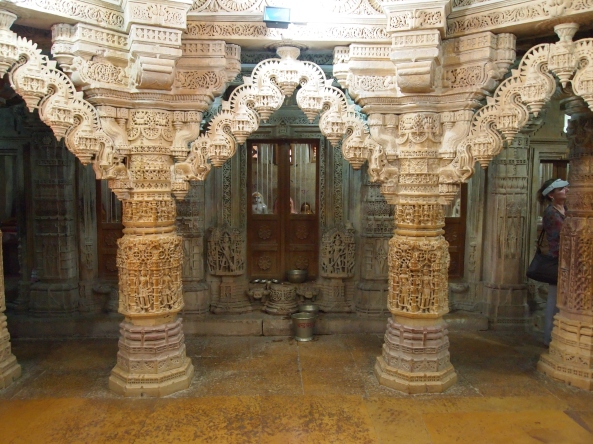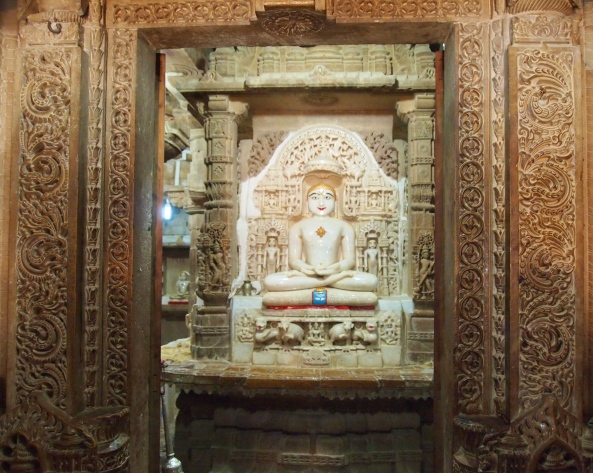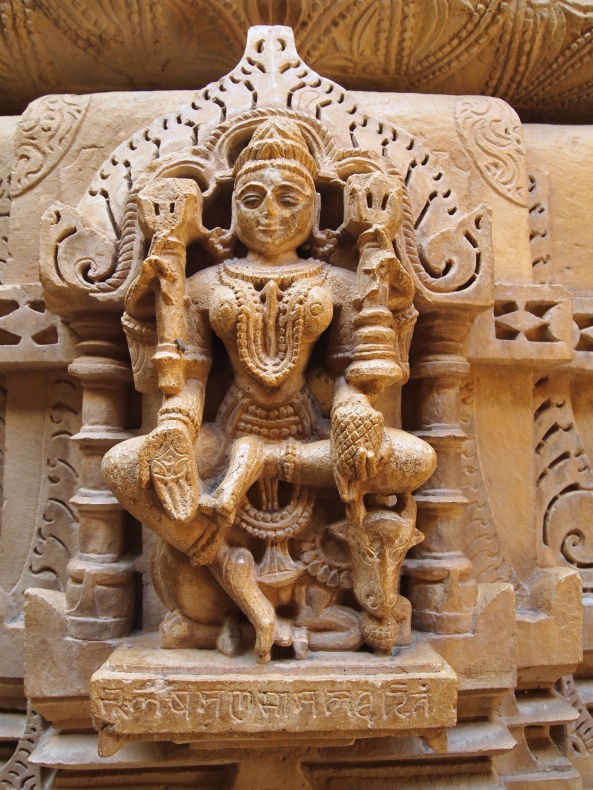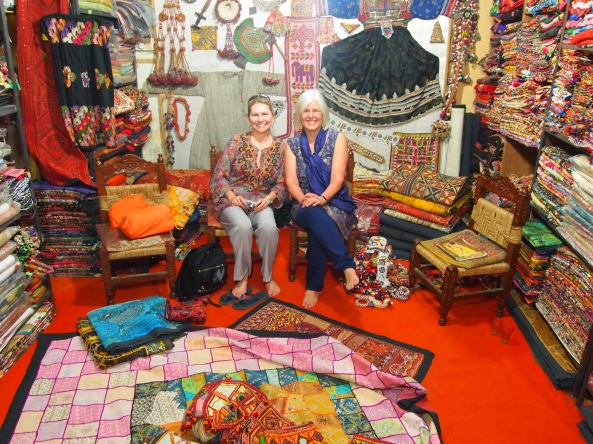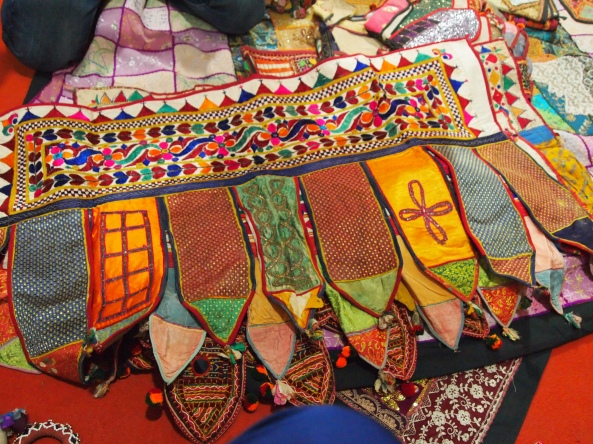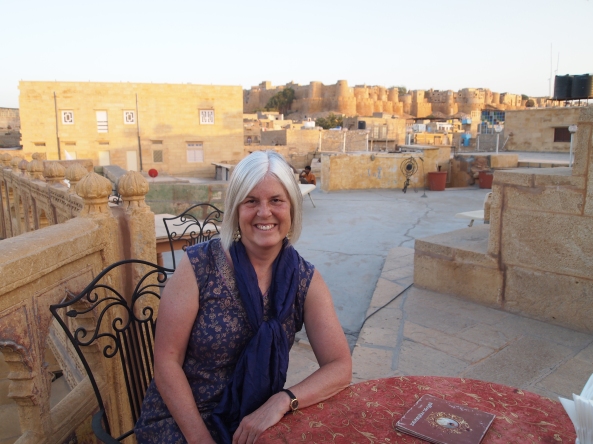Tuesday, March 15: We’re picked up in the morning by our non-English speaking (and still greasy) driver accompanied by an English-speaking Indian who will be our guide for the day. We usually like to wander about on our own, but on this day, because our driver doesn’t speak English, the hotel has arranged this guide. In the end, we are happy to have him because we would have just wandered aimlessly around Jaisalmer not having a clue what we were seeing. We arrive at the Jaisalmer Fort, where, outside the gates, are multitudes of beautiful textiles hanging outside shops. It is a hot day, as every day is here in the desert. Nonetheless, I can tell I will like this place with its shopping enticements!
We enter through the huge gates of Jaisalmer Fort, built in 1156 by the Rajput ruler, Jaisala, and reinforced by subsequent rulers. The fort encloses narrow streets paved with sandstone, a maharaja’s palace, temples and havelis, and sits atop the Trikuta hill. This place is one of my favorite forts because it is so much more than a tourist attraction; it is actually a living museum as a significant portion of the old city’s population resides within the fort walls.
We bypass the Maharaja’s palace, and our guide takes us directly to one of the seven beautiful yellow sandstone Jain temples that were built from the 12th to the 16th centuries. We go into a number of these temples, which inside have incredibly intricate and golden-glowing carvings. We encounter orange-robed monks and hundreds of marble images of Parasnath, the 22nd tirthankar. Tirthankars are the 24 great Jain teachers. The carvings are exquisite and the marble floors, on which we walk barefoot, are cool and relaxing. It’s lovely wandering through these temples.
We see signs in these temples: “Please do not give tips to holy men. All gifts please place in donation box instead.”
Another sign outside of one of the Jain temples: “Important – Notice”: Entrance of ladies during monthly course period is strictly prohibited. They are requested to maintain the sanctity of the temples.
Hmmm….. Didn’t God create women to have monthly cycles? Why should they be considered “dirty” during these times?
We wander into many shops along the narrow streets. Our guide has his own shop of painted ceramic doorknobs and wall hooks, similar to those sold in anthropologie and Pier One in the U.S. I buy a wall hook for myself and one for my daughter. We wander into silver shops, where we buy earrings. And we spend a great deal of time in a cool textile shop, drinking tea with the young Indian shopkeeper. After much haggling, we each buy “Welcome” door-hangings. These are crenellated embroidered textiles that you hang at the top of your doorway to welcome guests.
Our guide also takes us further through the narrow streets, pointing out gorgeous havelis, most notably the Patwa-ki-Haveli, towering over a narrow lane with its honey-colored lace stonework. A haveli is a traditional, often ornately decorated, residence, particularly found in Rajasthan and Gujarat. This one was built between 1800 and 1860 by five Jain brothers who were brocade and jewelry merchants. However, there are claims that these traders made a considerable amount of money in opium smuggling and money-lending. This is the largest haveli in Jaisalmer and looms over a narrow lane.
The streets of Jaisalmer Fort are much cleaner overall than streets in most of India. Compared to a place like Varanasi, they are spotless. However, cows do still wander the streets, and at one point we have to pass by a cow blocking a narrow lane. He has crap smeared all over his behind, and I am disgusted as I have to pass close by. I’m afraid he will back me into a wall with his shit-covered ass, or he will flick his tail, splattering me with his mess. Luckily that doesn’t happen!
At another point, we find a little boy squatting over a gutter outside his home, pooping a yellow mushy mess into it that attracts flies like a sucking magnet.
After much wandering through the fort, we return to the hotel and relax in our cool room and then go outside and hang out in the pool and relax on swinging chairs. We take some pictures of each other in our bathing suits, which are not suitable for publication.
Later, our driver takes us into town for dinner. We go to the Lonely Planet-recommended Saffron, which is on the rooftop of the Nanchana Haveli, overlooking Gandhi Chowk. A chowk is a town square, intersection, or marketplace. The setting is suberb, with its sandstone terrace overlooking not only the Chowk, but also Jaisalmer Fort on the hilltop behind. It’s really atmospheric. We both wish we had some romantic interest in our lives that we could be with in this spot. However, we have to settle just for each other…
We find ourselves in an argument with the waiter about the wine, which we don’t like because it’s sweet and bubbly. We’re used to being able to taste our wine before purchasing, as in American restaurants. After we order a different wine, they tell us we MUST pay for this one, whether we like it or not. We snack on Poppadum, or crisps, while we wait for our dinner.
For dinner, we eat delicious Dum Aloo Kashmiri, or potato barrels filled with dry fruits and mashed vegetables; Vegetable Seekh Kebab, or assorted mashed vegetables with mild spices on a skewer cooked in a clay oven. The dinner is delicious.
Some performers come up as the sun is setting. They are really cute, banging on drums and playing flute-like instruments. One of the young guys asks us our names and then proceeds to sing this funny wailing kind of tune, singing our names: “Caaaattthyyy! Jayyyynnnnniiiiieeee!” and waving his arm in a snake-dance way. We laugh and laugh, carrying our laughter with us into the night and back to our hotel.
After dinner we explore the Nachana Haveli, the 280-year-old sandstone haveli converted to a hotel. All the common areas are sumptuously and romantically decorated, with Rajput trimmings such as swing chairs and bearskin rugs. After, we go outside to explore some shops in the Chowk while we wait for our driver. We return to our hotel where we fall asleep, exhausted from the heat and our wine and filling dinner.








